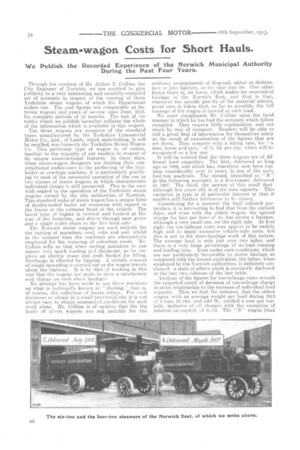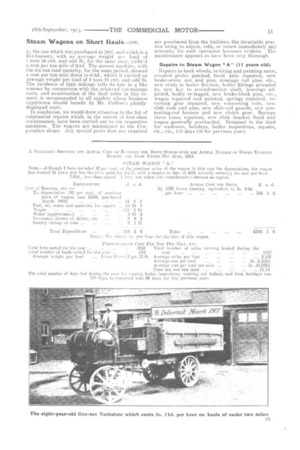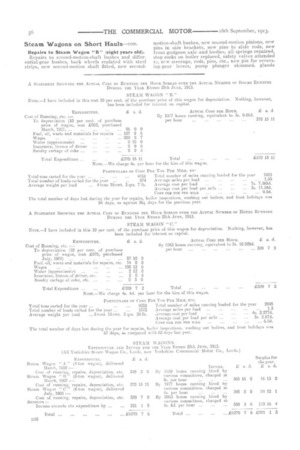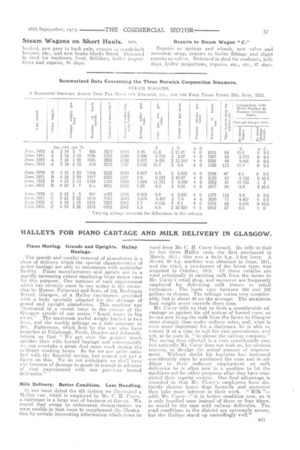Steam-wagon Costs for Short Hauls.
Page 4

Page 5

Page 6

Page 7

If you've noticed an error in this article please click here to report it so we can fix it.
Publish the Recorded Experience of the Norwich Municipal Authority During the Past Four Years.
Through the courtesy of Mr. Arthur E. Collins, the City. Engineer of Norwich, we are enabled to give publicity to a. very interesting and carefully-compiled set of accounts in respect of the running of three Yorkshire steam wagons of which his Department makes use. The cost figures are comparable as between. wagons and years of service since June, 1930, for complete periods of 12 months. The last of tile tables which we publish hereafter collates the whole of the information which is available in this respect.
The three wagons are steamers of the standard types manufactured by the Yorkshire Commercial Motor Co., Ltd., of Leeds, which undertaking, it will be recalled, was formerly the Yorkshire Steam Wagon Co. This particular type of wagon is, of course, familiar to the majority of our readers in respect of its unique constructional features. In these days, when steam-wagon designers are limiting their constructional endeavours to the perfecting of the locoboiler or overtype machine, it is particularly gratifying to read of the successful operation of the one or two classes of steam wagons in which characteristic individual c7,esign is still preserved. This is the case with regard to the operation of the Yorkshire steam wagons owned by the city authorities of Norwich. This standard make of steam wagon has a unique form of double-ended boiler set crosswise with regard to the frame at the extreme front of the vehicle. The latest type of engine is vertical and located at the rear of the footplate, and drives through spur gears and a single roller chain to the live hind axle.
The Norwich steam wagons are used entirely for the carting of macadam, coal, coke and soil, whilst in the summer time the machines are alternatively employed for the watering of suburban roads. Mr. Collins tells us that when carting macadam he can ensure very quick loading aid discharge, as he employs an electric crane and grab bucket for filling. Discharge is effected by tipping. A certain amount of rough spreading is carried out as the wagon travels along the highway. It is by dint of working in this way that the wagons are made to show a satisfactory cost charge on such short haulages.
No attempt has been made to use these machines on what is technically know.n as " dusting," that is, of course, the collection of house refuse. For such distances as obtain in a small provincial city it. is rot always easy to obtain economical conditions for such work alone. Mr. C4311ins is of opinion that the big loads of stenna wagons are not suitable for the ordinary arrangements of disposal, either at destructors or into lighters, as tha, case may be. One other factor there is, we learn, which makes for economical haulage in the Norwich fleet, and that is that, wherever the specific gravity of the material admits, great care is taken that, so far as possible, the full tonnage of the wagon is carried at each load. We must compliment Mr. Collins upon the lucid manner in which he has had the accounts which follow compiled. They require little explanation, and not much by way of comment. Readers will be able to cull a great deal of information for themselves solely as the result of examination of the figures that are set down. They compete with a hiring rate, for "a man, horse and cart," of 7s. 3d. per day, which will ho recognized as a low one.
It will be noticed that the three wagons are of different load capacities. The first, delivered so long ago as 1902, and which has, therefore, now been running considerably over 11 years, is one of the early four-ton machines. The second, identified as " B " in the following accounts, is a five-tonner, delivered in 1907. The third, the newest of this small fleet although five years old, is of six tons capacity. This variation in type is of particular interest in that it enables still further inferences to ba drawn.
Considering for a moment the final collated particulars, it is interesting to find that from the earliest days, and even with the oldest wagon, the agreed charge for hire per hour of ts. has shown a balance, although a very small one, on the right side. At first sight the ton-mileage costs may appear to be unduly high and to imply excessive vehicle-mile costs, but this is not so for short-haulage work of this nature. The average haul is only just over two miles, and there is a very large percentage of no-load running and loading time. Even under such conditions, which are not particularly favourable to motor haulage as compared with the horsed equivalent, the latter, when employed by the Norwich authorities, is definitely outclassed—a state of affairs which is succinctly disclosed in the last two columns of the last table.
Analysis of the figures for ton-mileage costs reveals the expected result of decrease of ton-mileage charge in strict relationship to the increase of individual load capacity. Thus we find, for instance, that the oldest wagon, with an average weight per load during 1913 of 3 tons 19 cwt. and odd lb., yielded a cost. per tonmile, inclusive of all charges with the exception of interest on capital, of 11.7d. The "B " wagon (that -L-;, the. one which was purchased in 1907, and which is a five-tonner), with an average weight per load of 4 tons 19 cwt. and odd lb., for the same year, yieldcd a cost per ton-mile of 9.5d. The newest machine, with the six-ton load capacity, for the same period, showed a cost per ton-mile down to 6.5d., whilst it carried an average weight. per load of 5 tons 15 cwt. and odd lb. The incidence of high mileage tells its tale in a like manner by comparison with the achieved ton-mileage costs, and examination of the final table in this respect is recommended to all readers whose business experience should benefit by Mr. Collins's plainlydisplayed costs.
In conclusion, we would draw attention to the list of substantial repairs which, in the course of first-class maintenance, have been carried out to the respective machines. The wagons are maintained in the Corporation shops. Any special parts that are required
are purchased from the builders, the invariable practice being to adjust, refit, or renew immediately any necessity for such operation becomes evident. The maintenance appears to have been very thorough.
Repairs to Steam Wagon "A" (1 1 years old).
Repairs to back wheels, re-tiring and painting same, crooked girder patched, front axle repaired, new brake-screw nut and pins, steerage rod pins, etc., new studs in boiler fire-box, boiler fittings attended to, new key to second-motion shaft, bearings adjusted, boiler re-lagged, new brake-block pins, etc., wagon repaired and painted, springs repaired, reversing gear repaired, new connecting rods, new slide rods and pins, new slide-rod guards, new connecting-rod brasses and new clutch gear. Springs three times repaired, new slide bracket fixed and wagon generally overhauled. Detained in the shed for washouts, holidays, boiler inspections, repairs, etc., etc., 113 days (49 for previous year). Repairs to Steam Wagon "B" (eight years old).
Repairs to second-motion-shaft bushes and differential-gear bushes, back wheels replated with steel strips, new second-motion shaft fitted, new second motion-shaft bushes, new second-motion pinions, new pins in side brackets, new pins to slide rods, new front gudgeon axle and bushes, all springs repaired, stop cocks on boiler replaced, safety valves attended to, new steerage, rods, pins, etc., new pin for reversing-gear levers, pump plunger skimmed. glands bushed, new gear to back axle, repairs to crankshaft brasses, etc., and new brake blacks fitted. Detained in. shed for washouts, frost, ITalidays, boiler inspeetions and repairs, 94 days.
Piano Moving. Grands and Uprights. Halley Haulage.
The speedy and careful removal of pianofortes is a class of delivery which the special characteristics of motor haulage are able to encompass with particular facility. Piano manufacturers and agents are to a rapidly increasing extent employing large motor vans for this purpose. One instance, of such employment which has recently come to our notice is the ownership by Messrs. Patterson and Sons, of 152, Buchanan Street, Glasgow, of a Halley two-tormer, provided with a body specially adapted for the stowage of gland and upright pianofortes. This machine was illustrated in a recent issue in the course of the, Glasgow article of our series " Small users in big cities." The ma,ximura useful weight hauled is two tons, and the weekly mileage as a rule amounts to 300. Pattersons, which firm by the way also have branches at Edinburgh, Perth, Dundee and Arbroath, inform its that " We get over the ground much quicker than with horsed haulage and consequently we can overtake a great deal more work during the ordinary working hours. So far we are quite antisfled with the financial saving, but cannot yet put a figure -on this. We do not anticipate we shall have any increase of damage to goods in transit in advance of that experienced with our previous horsed deliveries."
Milk Delivery. Better Condition. Less Handling.
In our issue dated the 4th instant we illustrated a Halley van, which is employed by Mr. C. II. Curry, a dairyman in alarge way of business at Govan. We regret that owing to unforeseen circumstances we were unable in that issue to supplement the illustration by certain interesting information which came to Repairs to springs and wheels, new valve and eccentric strap, repairs to boiler fittings and slight repairs to valves. Detained in shed for washouts, holidays, boiler inspections, repairs, etc., etc., 67 days.
hand from Mr. C. H. Curry himself. He tells us that he has three Halley vans, the first purchased in March, 1911 ; this was a28-34 h.p. 3-ton lorry. A 30-ewt. 20 h.p. machine was obtained in June, 1911, and the third, a two-termer of the latest type, was acquired in October, 1912. All these vehicles are used principally in carrying milk from, the farms to Mr. Curry's retail shop, and moreover are frequently employed for delivering milk thence to retail customers. The loads vary between 200 and 500 gallons in churns. The mileage varies very considerably, but is about 50 on the average. The maximum load weight never exceeds three toes. Mr. Curry tells us that he finds a considerable advantage as against his old system of horsed vans, as he can now bring the milk from the farms to Glasgow more cheaply than under railway rates, and, what is even more important for a dairyman, he is able to convey it at a time to suit his own convenience, and not, as he puts it, " to please the railway company." The saving thus effected is a very considerable one, but naturally Mr. Curry does not wish us, For obvious reasons, to divulge the actual amount: of improvement. Without doubt his business has increased considerably since he purchased the vans and in addition to their ordinary employment on milk deliveries he is often now in a position to let the machines out for other purposes after they have completed their regular routine. One final advantage is recorded in that Mr. Curry's employees have distinctly shorter hours than formerly and moreover they take more interest in their work. " Milk "adds Mr. Curry-" is in better condition now, as it is only handled once instead of three or four times, as would be the case with railway deliveries. The road conditions in the district are extremely severe, but the Halleys stand up exceedingly rell."






















